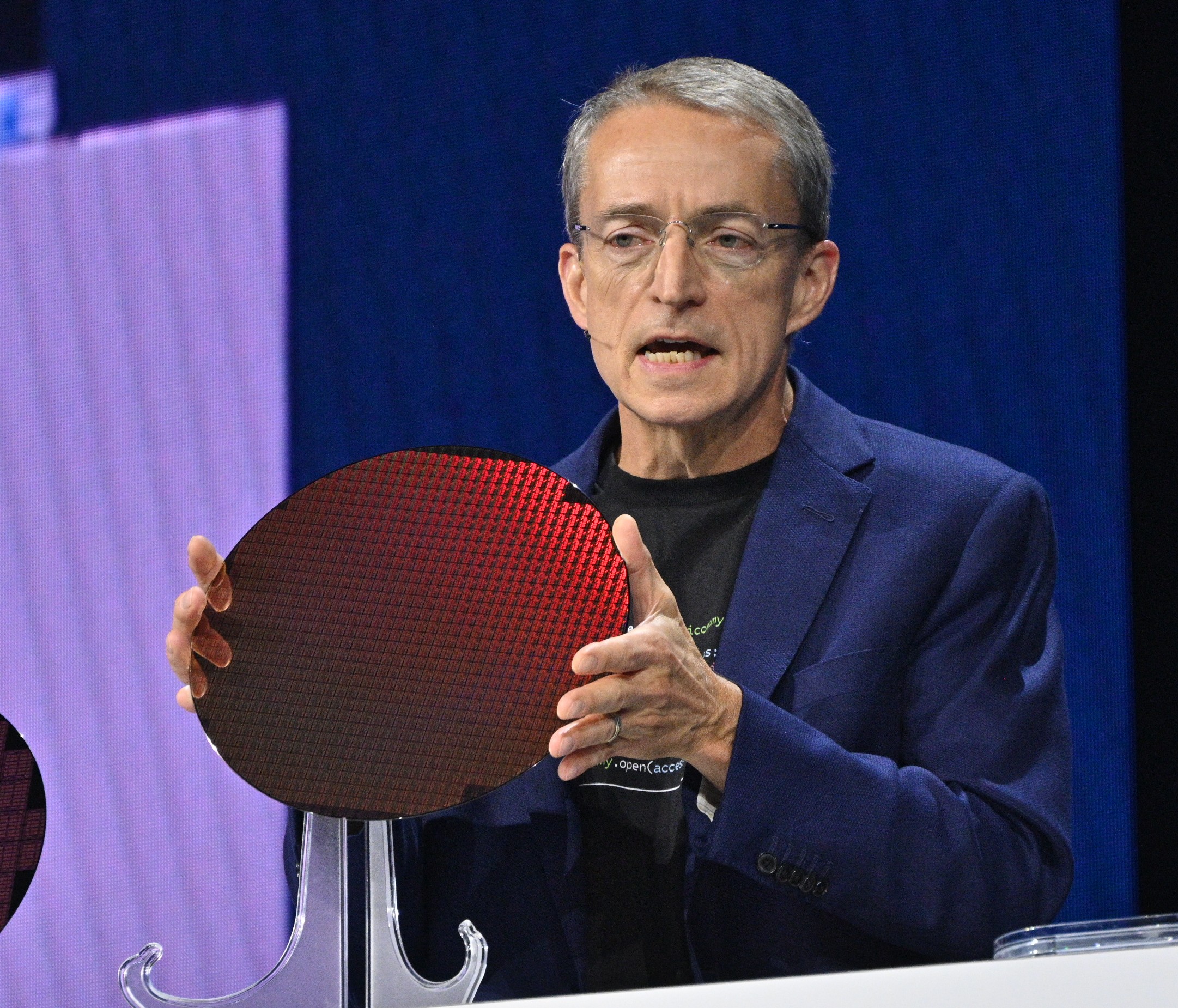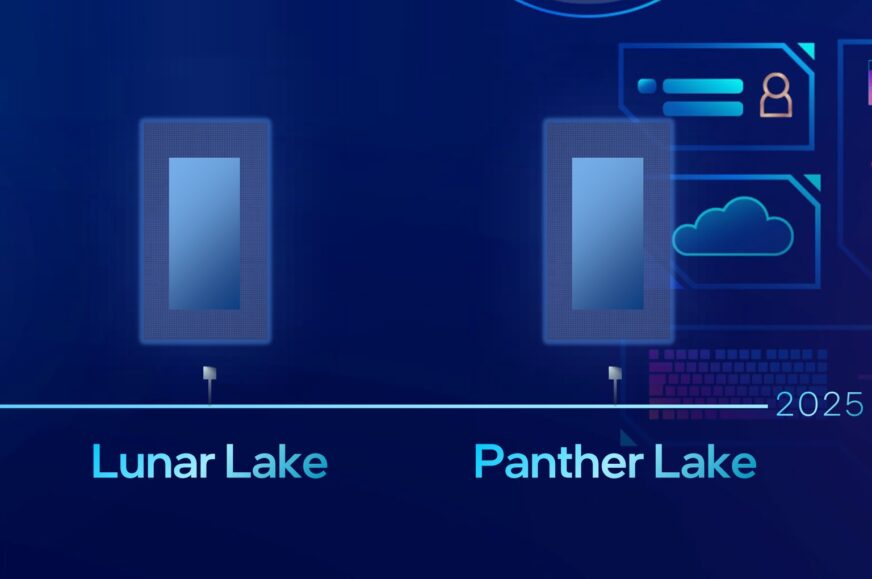Roadmap of Intel client processors for 2024 and 2025
Intel took a symbolic “step into the future” by unveiling Meteor Lake processors now, for the first time using TSMC-manufactured silicon as well as advanced chiplet design with 3D Foveros technology. Meteor Lake will come out at the end of the year, but Intel has also revealed a roadmap of processors for PCs and laptops, showing what will come after it. Three new generations or families of “lake” processors are coming in 2024 and 2025.
In case you missed it in all the other chaos, Intel has confirmed the date when Meteor Lake processors, or laptops with them, will go on sale – in a bit unusual turn of things, it’s just before the end of 2023 (December 14), barely this year. Meeting the 2023 deadline was very likely a crucial goal that Intel tried its best to meet. For reputation’s sake no doubt, but what probably plays a role in this as well is the fact that next year, the next generation is due to arrive. Or maybe even two generations.
Intel has confirmed that it will release processors manufactured using its 2nm node (Intel 20A) in 2024. Alongside these, 3nm processors for Sierra Forest servers will also come out, but Intel will skip this technology in PC processors and go straight to the Intel 20A process. This node is supposed to be something that originally evolved from the technology that Intel previously referred to as the 5nm process in roadmaps. So it should roughly compete with TSMC’s 3nm technology, if we rely on the old rule that Intel nodes used to be comparable to foundry nodes that were nominally a generation ahead.
But it is possible that over the years the parameters have changed and the process is targeting a more aggressive result, so that eventually it could actually be able to compete even with TSMC’s 2nm technology. Intel’s 20A process is supposed to use RibbonFET transistors, which is another name for the GAAFET transistor structure that TSMC intends to deploy on the 2nm process as well.

Arrow Lake
The first 2nm (20A) processor to be released is the Arrow Lake generation. These should once again be a standard mainstream processor family for the entire PC market, in the sense that it will no longer be limited to just the laptop version (which will probably be fairly similar to the concept now shown by Meteor Lake), but also as desktop processors. Coming with them will be a new platform with LGA 1851 socket, which was originally supposed to have debuted with the desktop Meteor Lake, before the socketed versions getting cancelled.
LGA 1851 is expected to bring improved connectivity – such as PCIe 5.0×4 for SSDs connected directly to the CPU. It seems that Arrow Lake desktop processors will bring chiplet CPU design to this segment as well, so desktop Intelu CPUs will no longer be monolithic.
Arrow Lake is supposed to use a new architecture of performance CPU cores, perhaps codenamed Lion Cove. It should therefore increase IPC and improve single-threaded performance compared to Meteor Lake. There have been rumors that this architecture could do away with HT, but that’s still anecdotal unconfirmed stuff. The Crestmont architecture used by efficient cores could presumably remain unchanged compared to Meteor Lake, but that would still make it a new core versus today’s Raptor Lake and Alder Lake.
These processors are supposed to come out in 2024. It’s likely that it will be in the second half of the year – in the fall, which is the usual time for Intel to launch new generations, or at the end of the year. However, Intel hasn’t stated the exact date yet.

Lunar Lake
The second processor family, called Lunar Lake, will not be as universal as Arrow Lake. These, it seems, will be low-power processors optimized for mobile devices. They also use the same 2nm process and thus seem to not be a generational successor to Arrow Lake (the next generation), but rather something of a parallel same-generation complement to it. Perhaps similar to how there were once parallel families of Whiskey Lake and Amber Lake processors. This means a desktop version of Lunar Lake is not expected.
Lunar Lake processors could also come out in 2024 (probably after Arrow Lake), but it’s not as certain as with Arrow Lake. So theoretically they could slip into 2025.
Since it’s probably supposed to be a sister generation, the same Lion Cove big core is likely to be used. However, it has been reported that the little cores might be different in these CPUs (the Skymont designation has been quoted for them – but Intel has not officially disclosed this).

First 2nm processor demo
Intel showed a sample of a Lunar Lake processor in action for the first time at InnovatiOn. The processor was hidden in a reference laptop and only its AI unit was demonstrated. It should already use the next generation compared to the NPU used in Meteor Lake, and perhaps even be the third generation after the second generation in Arrow Lake.
A Stable Diffusion-style generative AI tool was running live on the laptop, which painted a picture of a giraffe in a hat and generated a song on the prompt “in Taylor Swift style” (this should be the work of the Riffusion plugin for Audacity, which is supposed to mimic the style of the chosen artist). While most observers would probably prefer to see some demos of CPU or GPU performance already, it’s probably too early for that at this point. The goal here was probably just to demonstrate that Intel already has working samples of these CPUs capable of running a similar live demo.
2025: 1,8nm process and Panther Lake
The actual new next generation successor to Arrow Lake will be Panther Lake processors. These will come out, as per the officially communicated schedule, in 2025 (we can probably assume again that it’s rather the second half of the year, to maintain the annual cycles). Panther Lake could perhaps bring a new or updated architecture again, but details are still missing. These processors, unlike the specialized Lunar Lake, should again come to both laptops and desktops. It could thus form the second generation of processors on the LGA 1851 platform.
But what Intel has confirmed is the manufacturing node. These processors will be the first to use Intel’s 1.8nm 18A node. This should add backside power delivery technology (under the PowerVia designation), where the metal wires used to power the chip are implemented completely separately from the metal layers forming the logic circuitry itself.

Patrick Gelsinger (as Intel’s current CEO) said during Intel InnovatiOn that Panther Lake should undergo tape-out (“go to the factory”) – or as Intel says, tape-in – as early as Q1 2024. This could allow Intel to actually release these processors in maybe two years from now (September or October 2025). Of course, we can’t be sure that the manufacturing process won’t suffer from delays again, as this has plagued the last few generations apparently including the 4nm process. Intel announced a tape-in of the 4nm Compute chiplet as early as March 2021, but the release of the full processor won’t be until late 2023.
Delays are exactly what Intel is trying to eliminate under the new CEO. The launch of 1.8nm chips is meant to complete Patrick Gelsinger’s plan to bring five manufacturing processes (Intel 7, Intel 4, Intel 3, Intel 20A, Intel 18A) into production in four years (2021–2024). If the push is successful, perhaps we will see fewer “filler” processor generations like Raptor Lake Refresh (and actually, Raptor Lake was partially a filler generation already) from Intel in the future, and there will be greater innovation involved in each annual generation. But it remains to be seen if Intel will be able to turn these goals into reality.
Sources: AnandTech, VideoCardz, Intel
English translation and edit by Jozef Dudáš
⠀








